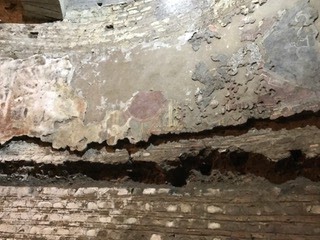 Although one would never suspect it approaching this basilica, which sits along the side of a busy city street, this location has a strong claim to being the site of the oldest purpose-built church in Rome. It is connected with the name of Chrysogonus, a fourth century military officer martyred under Diocletian in 304 in northern Italy, near the city of Aquileia. His cult soon became popular in Rome, with his name being included in the Roman Canon. Soon after these persecutions ended, a large hall was constructed on this site, to which an apse was later added. Many archeologists see this as a building intended from the start for Christian worship, apparently built even before the Edict of Milan.
Although one would never suspect it approaching this basilica, which sits along the side of a busy city street, this location has a strong claim to being the site of the oldest purpose-built church in Rome. It is connected with the name of Chrysogonus, a fourth century military officer martyred under Diocletian in 304 in northern Italy, near the city of Aquileia. His cult soon became popular in Rome, with his name being included in the Roman Canon. Soon after these persecutions ended, a large hall was constructed on this site, to which an apse was later added. Many archeologists see this as a building intended from the start for Christian worship, apparently built even before the Edict of Milan.
 |
| Looking down into the foundations of the original church |
Later in the fourth century, further provision for liturgical functions was made, a sign of the increasing level of comfort that Roman Christians felt about publicly expressing their faith. This building apparently lasted until the early twelfth century, as the current building was begun in 1123 somewhat to the right of the original basilica; the left row of columns in the nave stand over the right wall of the original church. The floor of the current basilica dates from around this period, being a good example of cosmateque stonework. Mosaic sections of the floor near the sanctuary depict the heraldic symbols of the Borghese family, added under Scipione Cardinal Borghese. He is largely responsible for the current interior of the building, dating from a renovation in 1623. The cardinal’s name can be found on the pediment over the porch, as well as on the ciborium over the altar. A further renovation was carried out in the mid-1860s, from which the chapel at the end of the left aisle and the choir stalls in the apse are the two most noteworthy additions. This was shortly after the basilica was placed in the care of the Trinitarian Order, who still serve here today.
 |
| Symbol of the Trinitarians inside the Baldacchino |
Up the left aisle is a chapel dedicated to Bl. Anna Maria Taigi (1769-1837) - a Trinitarian tertiary who is recognized for her sanctity in family life, her charitable deeds, and her mystical prayer life. Her body is under the altar, over which is an image of Our Lady, Refuge of Sinners. Other images are of Trinitarian saints, including St. Felix of Valois prayer with the Blessed Virgin, and another of her giving money to St. John de Matha for the payment of a ransom. These two saints are the founders of the Trinitarian order, originally created for the purpose of freeing Christian slaves.
Above the baroque ciborium in the sanctuary is a stucco relief depriving the trial and martyrdom of St. Chrysogonus. Lower is a late 13th century mosaic of the enthroned Madonna and Child between St. Chrysogonus and St. James the Greaser relics of both os whom are beneath the high altar, visible through a grate.
Entering the sacristy we were able to go down to the excavations of the earlier church (mentioned above). Normally it is difficult to get down there - but they opened it up for us this morning. Incredible to see the ancient foundations of this Church!
 Although one would never suspect it approaching this basilica, which sits along the side of a busy city street, this location has a strong claim to being the site of the oldest purpose-built church in Rome. It is connected with the name of Chrysogonus, a fourth century military officer martyred under Diocletian in 304 in northern Italy, near the city of Aquileia. His cult soon became popular in Rome, with his name being included in the Roman Canon. Soon after these persecutions ended, a large hall was constructed on this site, to which an apse was later added. Many archeologists see this as a building intended from the start for Christian worship, apparently built even before the Edict of Milan.
Although one would never suspect it approaching this basilica, which sits along the side of a busy city street, this location has a strong claim to being the site of the oldest purpose-built church in Rome. It is connected with the name of Chrysogonus, a fourth century military officer martyred under Diocletian in 304 in northern Italy, near the city of Aquileia. His cult soon became popular in Rome, with his name being included in the Roman Canon. Soon after these persecutions ended, a large hall was constructed on this site, to which an apse was later added. Many archeologists see this as a building intended from the start for Christian worship, apparently built even before the Edict of Milan. 











No comments:
Post a Comment